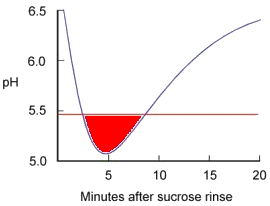To say that eating sweets causes decay is an oversimplification.
Usually it is how often the sweets are eaten that is a more accurate risk factor. After we have eaten, our mouth is usually acidic for a while – and especially when there is plaque on a tooth, the bacteria will produce acid which, when saliva is below pH 5.5 our tooth surface starts dissolving.
When the tooth surface is dissolved by bacteria-produced acid it is called decay.
Stephan Curve of Decay Risk Period (see graph)
 Fortunately our saliva ‘washes away’ and neutralises the acidity, so our mouth is back to normal in an hour. But if we have another sweet, within 20 minutes of the first one – our mouth gets even more acidic, and takes even longer to get back to normal. A packet of Polos can leave your mouth acidic (with acid attacking your teeth) for most of the day!
Fortunately our saliva ‘washes away’ and neutralises the acidity, so our mouth is back to normal in an hour. But if we have another sweet, within 20 minutes of the first one – our mouth gets even more acidic, and takes even longer to get back to normal. A packet of Polos can leave your mouth acidic (with acid attacking your teeth) for most of the day!
Therefore, to summarise, the worst way to eat sweets (or biscuits etc.) is to have one after the other for a long period of time. If we do this our decay rate will be high and we will need loads of fillings.
Snacking between meals, especially of sugary snacks is often a regular habit and at uSmile we will often check any such habits with parents especially, to discuss whether they can be changed – ideally with non-sugary snacks, like nuts and crisps.






